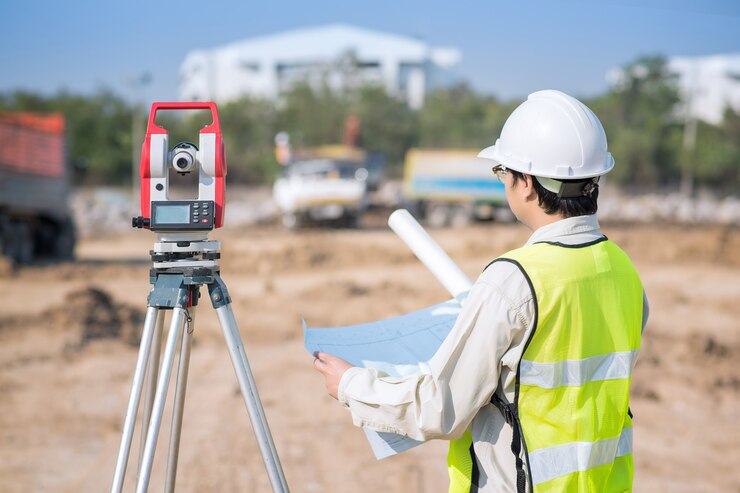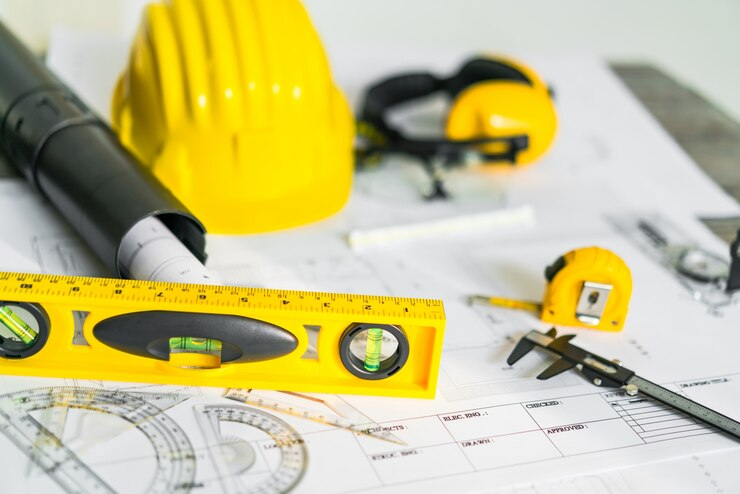Land surveys play an essential role in shaping the future of urban development. Surveys provide information about land’s physical characteristics and boundaries and help plan the city. It also helps the developers to make informed decisions.
With the help of land surveys, professionals can easily measure and map out various aspects, i.e., topography, property boundaries, and existing infrastructure. While planning for urban projects, this data is the base and helps new developments align with existing structures and adhere to zoning regulations. In this comprehensive exploration, we’ll delve into how land surveys contribute to and shape the trajectory of urban development.
Understanding the Foundation: What is a Land Survey?
A land survey is the scientific process of measuring the dimensions of a particular area of the earth’s surface, including its horizontal distances, directions, angles, and elevations. It includes measuring and mapping out all the physical and legal details of the property. It means figuring out exactly where the boundaries are, understanding the land’s shape, and noting existing buildings. This information is super essential for knowing where the property ends, deciding if it’s good for building things and spotting any problems or limits it might have.
The Blueprint for Infrastructure Planning
One of the main ways land surveys contribute to the effectiveness of a city is by serving as a model for infrastructure planning. Cities rely on accurate survey data to map the layout of roads, infrastructure, and public spaces. This careful planning ensures that infrastructure is strategically placed to meet the aspirations of the growing population, reduce congestion, and beautify all city functions.
Road Networks:
Land surveys are a crucial part of planning and developing road networks. They provide detailed information about the terrain, geography, and existing structures or features along a proposed road route.
Utility Placement:
Survey data is instrumental in determining the optimal placement of utilities such as water and sewer lines, gas pipelines, and electrical grids. Proper infrastructure planning based on land surveys helps prevent service disruptions and inefficient resource distribution.

Promoting Sustainable Urban Development
As cities strive to become more sustainable, land surveys are vital in guiding environmentally conscious development practices. Survey data aids in identifying green spaces, wildlife habitats, and areas of ecological importance. This information is invaluable for implementing sustainable design principles and preserving the natural elements within urban landscapes.
Green Spaces and Parks:
Land surveys help identify suitable locations for green spaces and parks, creating healthier and more livable urban environments. Preserving these areas enhances biodiversity, provides recreational spaces, and improves overall quality of life.
Floodplain Analysis:
In flood-prone areas, accurate surveys are crucial for delineating floodplains. This information is vital for implementing effective flood control measures and preventing the development of vulnerable regions.
Facilitating Real Estate Development
Land surveys give essential information to people who want to build new things. It shows what the land looks like. They show where the hills and flat lands are. They show where the water goes when it rains. Surveys also find where people have already built things nearby.
With good surveys, builders know what the land can be used for. Surveys help decide the best spot to build houses. Or stores. Or factories. Surveys show where roads and pipes under the ground should go.
Zoning Compliance:
Land surveys help builders ensure their projects comply with nearby local codes. It is essential to understand permitted land uses, setbacks, and density requirements and obtain the necessary permits and approvals.
Site Design and Planning:
From considering the aesthetic placement of buildings to the impact on neighboring homes, the online design of the land survey book website, and planning. This nuanced approach reduces conflict, creates better land use, and contributes to comprehensive management.
Mitigating Legal Challenges
Having land surveyed helps avoid problems later over where one piece of land ends and the next starts. Without surveys, people might fight over where fences and buildings should go.
Surveys mark the exact property lines on the ground. Licensed surveyors carefully measure the land using GPS and other tools. They place metal pins and caps to show the corners and boundaries.
The survey report files the legal details about the land at records offices. Doing this makes clear who owns what. Banks need surveys to know if the property used for loans is right.
In the future, the survey will keep misunderstandings or lawsuits from happening. Buyers and sellers have proof of where the lot lines are. Title companies can insure the property based on the survey, too. Relying on surveys early prevents expensive fights over property lines down the road. The upfront cost brings significant savings by making ownership clear for all.
Boundary Disputes:
Land surveys precisely map property lines. Detailed surveys by licensed professionals document boundaries. This official record minimizes neighbors disputing over where one land ends and the next begins. With clear marker points and documentation, land surveys provide clarity. This prevents conflicts upfront and provides objective resolution if disputes arise later. Surveys bring confidence that borders are defined accurately without room for disagreement.
Easement Identification:
Surveys map legal limits on land use called easements & rights-of-way. Easements grant utility access or public access across private land. Rights-of-way serve purposes like rail lines. They identify these matters for legal compliance when planning property improvements or public works. Surveys pinpoint constraints, creating informed land use within established boundaries and averting violations.
Embracing Technological Advancements
Modern land surveys integrate technologies like satellite positioning (GPS), aerial drones, and data modeling. This allows faster, more precise property mapping. Detailed analytic tools help surveyors deliver comprehensive reporting to better inform land use. Technological integration has vastly grown land survey capabilities while increasing efficiency.

Aerial Surveys:
Drone-mounted cameras and laser sensors efficiently survey the land from above. Aerial drones accurately collect images and topography data across large or remote areas. Bird’s eye survey is helpful for construction site monitoring, precision crop analysis on farms, surveying disaster impacts, and creating detailed land maps. Drones expand and enhance aerial inspection and data acquisition.
GIS Integration:
Geographic Information Systems (GIS) synthesize land details into dynamic mapping. GIS allows the manipulation of layered aerial imagery, legal boundaries, topography, infrastructure, etc. This consolidates understanding of interacting community elements. GIS rendering empowers planners and developers to make sound decisions based on master plan visualization tools rather than disjointed data sets.
The Human Element: Surveyors as Urban Architects
Land surveyors blend technical skills with deeper insights. Precisely documenting boundaries and terrain takes proficient fieldwork. Translating data into usable plans requires understanding the impacts of planning, legal, and sustainability. Surveyors architect accessible blueprints that responsibly align proposals with constraints. Their expertise makes building right feasible through informing, not just measuring, the land’s story.
Interdisciplinary Expertise:
Modern land surveys inform more than just property lines and terrain. Surveyors increase value by collaborating across disciplines. Working with architects, urban planners, environmental scientists, civil engineers, and surveyors unify spatial contexts. Their property assessment integrates with studies on zoning constraints, utility infrastructure, sustainability impacts, and congestion insights. This interdisciplinary approach enables survey data to address project requirements beyond physical location directly. It allows balanced development planning through a shared lens weighing design, policy, economics, and conservation. When land surveyors synthesize perspectives, communities benefit from framing progress holistically rather than provisionally.
Community Engagement:
Effective urban growth consults the public. Land surveyors help by clarifying technical data for broader audiences. Using visuals, community gatherings, and easy-to-grasp reports, surveyors make spatial findings accessible. Getting feedback helps gauge feasibility and local priorities. Outreach that promotes understanding brings citizens into aligning quality growth with civic identity.
Challenges and Future Considerations
Urban growth strains surveyors balancing competing interests. Rapid development, sustainability goals, limited resources, and climate impact involve tradeoffs. Advanced technologies help but also disrupt. Continual innovation is imperative, though funding constraints persist. Staying current, climate-conscious, and collaborative pushes surveyors to master new complexities. How they balance economic pressures with environmental ethics shapes more livable cities. Meeting escalating demands calls surveyors to keep advancing standards for societal good.
Climate Change Resilience:
Land surveys now assess environmental shifts that alter property suitability. Changes like rising seas, erosion, flooding, and extreme weather increase risk profiles. Incorporating climate exposure helps surveyors provide cautionary breadth—mapping flood plains, storm surge zones, and areas prone to wildfires or drought overlay immediate impacts. Surfacing vulnerability empowers planners to avoid buildings where land use viability is endangered by intensifying climate effects.
Smart Cities Integration:
Urban efficiency gains hinge on data integration. As cities embed innovative technologies, vast information streams require consolidation. Land surveys provide an axis for environmental sensors, traffic monitors, utility meters, and more to enable responsiveness. Surveyors grow pivotal in collecting, combining, and applying data layers to inform intelligent infrastructure and services. The work of transforming raw metrics into insights that maximize resources and livability will shape surveying’s place in purposeful innovation.
Conclusion: Mapping a Sustainable Tomorrow
From initial planning to long-term adaptability, land surveys provide the foundation for appropriate urban growth. Technical expertise in precise land documentation enables infrastructure that respects constraints. Surveying’s insight into zoning, ownership, and environmental issues allows developers to align vision with viability sustainably. As cities navigate constant change, surveyors remain pivotal stewards. Their multifaceted understanding of legal, design, and conservation considerations makes space for livable density. Land surveys architect the proper boundaries to flourish within by revealing possibilities before the cement is poured. They silently map out smarter blueprints for all cities still to become.
